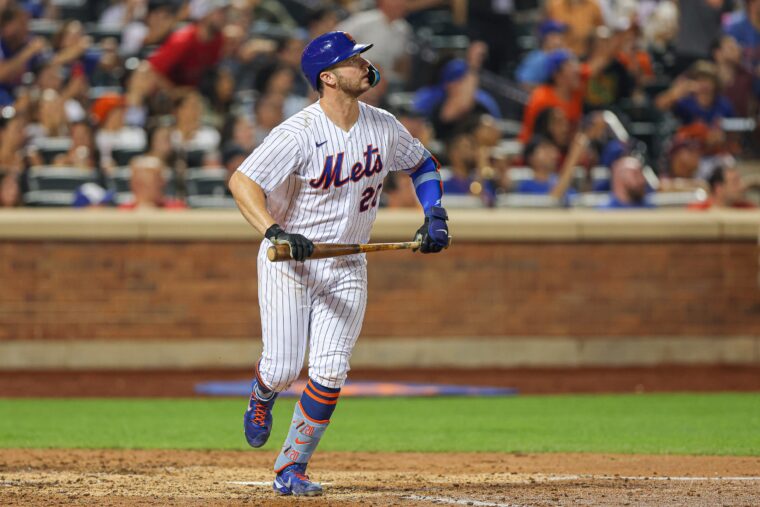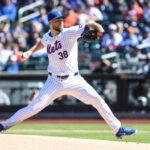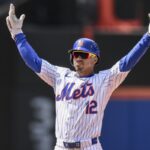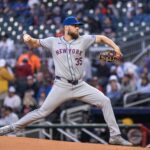
Vincent Carchietta-USA TODAY Sports
Pete Alonso already has the Mets’ single-season home run record. Now he’s after the RBI mark.
Following play on Monday, even with recent struggles, his current pace has him within sight of the 124 set by Mike Piazza and David Wright. And with under six weeks left in the regular season, his other number put him in the discussion for the greatest individual hitting seasons by a Met.
In addition to a National League-leading 102 runs driven in, his 30 homers, .514 slugging percentage, 148 OPS+ and 138 WRC+ are also ranked among the MLB’s elite. So how does the Polar Bear compare to other amazin’ single-season performances?
Cleon Jones (1969)
.340 BA/.422 OBP/.482 SLG, 151 OPS+, 154 WRC+, 5.5 offensive bWAR
Cleon Jones was a good hitter to begin his Mets career and became a great one just as the team was ready to ascend.
He started fast, hitting .410 in April, blasting five homers in May, and posting a June batting average of .341 to catapult the Mets into contention. His hot start earned him a spot as All-Star starter. A hurt leg in the second half didn’t stop Cleon from challenging Pete Rose and Roberto Clemente for the batting crown, though. Jones hit safely in 24 of the 29 games he played in August.
Jones ended up five points shy of Clemente and eight behind Rose, but his .340 average would stand as the highest ever by a Met until John Olerud surpassed it 29 years later. Jones cut his strikeouts down by 38 from 1968 and led the club in on-base percentage at .422. He was second on the team in RBIs, one short of Tommie Agee, and seventh in NL MVP voting.
Keith Hernandez (1984)
.311/.409/.449, 143 OPS+, 146 WRC+, 5.2 offensive bWAR
We all know he was an exceptional fielder, but his bat was pretty good too.
Keith Hernandez’s first full season in New York coincided with the Mets dramatically improving their record from 1983. His leadership and glove were obvious reasons for the turnaround (and being voted runner-up for NL MVP), but he also hit a team-best .311, clubbed 15 homers, had 31 doubles, and drove in 94. Keith topped the Mets in batting average, on-base percentage, OPS, and total bases. He also led with one clutch moment after another, using his cerebral knowledge of the strike zone to produce in key situations. The rest of the Mets followed his guidance as they were second to the Cubs in the NL East race with 90 victories.
Darryl Strawberry (1987)
.284/.398/.583, 162 OPS+, 159 WRC+, 7.2 offensive bWAR
For all the enormous hype given to him before he was drafted No. 1 overall by the Mets in 1980 and the All-Star seasons he had already put together in his young MLB career, it wasn’t until ’87 when his talents truly came together.
In spite of the distractions he caused, Darryl Strawberry’s on-field performance was a significant reason why the Mets overcame their abundance of injuries to the pitching staff and stayed in the NL East race with the St. Louis Cardinals. From September 1 until the end of the year, Strawberry drove in 28 runs and had an OPS of 1.058, and he was among the top 10 in the NL in home runs, OPS, RBIs, and steals. Strawberry and Howard Johnson became the first Mets to enter the 30-homer, 30-stolen base club.
Darryl Strawberry (1988)
.269/.366/.545, 165 OPS+, 159 WRC+, 6.2 offensive bWAR
Compared to his competition, Darryl’s better season was ’88. Compared to his best years, it’s a tougher call.
Strawberry led the NL in homers (39), slugging, and OPS. He began the year with a 4-for-4 day and two moonshots in Montreal. He’d hit 37 more to match his ’87 total. He topped 100 RBIs for the second straight season and was one steal short of back-to-back 30-30 years. For the first time, he was garnering serious consideration for MVP, thanks in part to the Mets running away with the division in September and claiming their second NL East title in three years. Strawberry missed out on the award to the Dodgers’ Kirk Gibson, mainly because Darryl’s votes were split with fellow outfielder Kevin McReynolds.
Howard Johnson (1989)
.286/.369/.559, 169 OPS+, 166 WRC+, 8.0 offensive bWAR
It’s a shame HoJo is not in the Mets Hall of Fame. One of the most under-appreciated hitters in team history also has one of the best hitting seasons. You could make a case this deserves to be at the top.
In earning his first trip to the All-Star Game as a starting third baseman, Johnson notched his second of three 30-30 years. He eclipsed 100 RBIs and 40 doubles for the first time and matched a career-best with 36 homers. Although he re-established career-bests in homers and RBIs two years later and led the NL in both categories, his 1989 season easily wins out—especially in terms of WRC+ (140 in ’91) and OPS+ (145).
Bernard Gilkey (1996)
.317/.392/.562, 155 OPS+, 152 WRC+, 6.0 offensive bWAR
His first season in New York was easily his best—not just as a Met, but for his entire major-league career.
Bernard Gilkey’s .317 batting average was eighth in the NL and his 44 doubles not only were fourth-best in the league but also established a new Mets single-season record. With fellow first-year New Yorker Lance Johnson at the top of the order and Todd Hundley in the middle each setting franchise marks themselves, it was one of the most productive offenses in years despite an underwhelming overall record. Gilkey’s success in New York got him MVP votes and was followed a cameo in “Men in Black,” although it exposed proneness to alien distractions while patrolling the outfield.
John Olerud (1998)
.354/.447/.551, 163 OPS+, 167 WRC+, 6.2 offensive bWAR
Players like Olerud are now getting the appreciation they truly deserve. The trade for Mike Piazza boosted the confidence of all Mets, but the power-hitting catcher’s insertion into the cleanup spot gave Olerud a chance to see good pitches more frequently.
Less than two months after Piazza’s arrival, Olerud went on a 23-game hitting streak. In September, he reached base 15 straight times, tying Barry Bonds for the NL record. After the streak, he proceeded to go 24-for-42 to finish out the year. Although Piazza’s presence was enormous, Olerud’s importance to the Mets cannot be overstated. He fortified his franchise-best batting average and on-base percentage with 96 walks to 73 strikeouts. His 307 total bases came from 22 homers, 197 hits, and 36 doubles. Olerud also drove in 93 runs and was third in the NL in wRC+.
Mike Piazza (2000)
.324/.398/.614, 155 OPS+, 153 WRC+, 5.5 offensive bWAR
Mike Piazza was the central figure in the Mets’ second straight playoff trip and their first World Series appearance in 1986. During this stretch, he further strengthened his hold on the “greatest power hitting catcher” title.
He was the team leader in homers for the third straight year, while his .324 batting average tied him with Edgardo Alfonzo. Piazza also drove in 113 runs. And for 15 consecutive games, spanning from June 14 through July 2, he tallied at least one RBI—two shy of the all-time MLB record. The streak reached its height on June 30, when he capped one of the greatest comebacks in team history and turned the tables on the hated Atlanta Braves.
Carlos Beltrán (2006)
.275/.388/.594, 150 OPS+, 148 WRC+, 7.0 offensive bWAR
It took a year for him to settle in. Once he did, Beltrán was everything Mets fans hoped for.
He set one Mets record—127 runs scored—and tied two others—80 extra-base hits and 41 home runs. None of those homers was more notable than the blow he struck—against the Cardinals, interestingly enough—which capped off a thrilling Mets rally on August 22. St. Louis likely thought it was safely ahead with a 7–1 lead in the fifth and a 7–6 lead in the ninth. In both instances, they thought wrong.
Beltrán’s two-run walk-off homer only added to the assurance that the Mets were the best in the National League. Of course, they came up one win short of proving it. Clichéd as it sounds, the Mets wouldn’t have reached that point without Beltrán in the lineup. He finished fourth in NL MVP voting but was clearly the most valuable Met.
David Wright (2007)
.325/.416/.546, 149 OPS+, 151 WRC+, 7.2 offensive bWAR
If a little thing like a collapse didn’t get in the way, he could’ve easily been the NL MVP. Even while the rest of his team was crumbling, David Wright maintained a torrid pace.
During a second half in which he slashed .364/.466/.596, Wright was especially vital to the offense in August and September—posting stellar OPS figures of 1.172 and 1.034 respectively. “The Captain” belted 30 homers for the first time in his young career and went over the 100-RBI plateau for the third straight season. Wright was outstanding at the plate with his best OBP and was a vastly improved base runner with 34 steals—joining the likes of Johnson and Strawberry in the 30-30 club.
Pete Alonso (2019)
.260/.358/.583, 147 OPS+, 144 WRC+, 5.6 offensive bWAR
His current season may not even be the best Pete Alonso season. If anyone expected that kind of first year, they’re kidding themselves. Considering the accomplishments he packed into such a short time—the franchise single-season home run record, the franchise single-season extra-base record, the major-league single-season rookie home run record, the 2019 major-league home run title, the 2019 NL Rookie of the Year, and the Home Run Derby crown—it’s hard not to call it the greatest rookie season in team history (perhaps even better than Dwight Gooden’s 1984).
With time, Alonso has developed into a more disciplined hitter. No matter how long he stays a Met, he’ll never have a year like 2019 because of how startling it was. Now we know who Pete Alonso is. And if his early career is any indication, he has a great chance to be among this group again.















